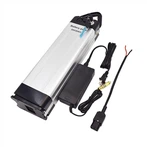Winter presents unique challenges for e-bikes, especially when it comes to battery care. Lower temperatures can affect the performance of lithium-ion batteries, leading to problems such as shorter range, slower charging, and even battery damage if not properly maintained. As a professional manufacturer of electric bicycle batteries, we produce batteries that can effectively resist the effects of low temperatures. Here are also some tips for winter battery maintenance.
The Impact of Winter on Lithium-Ion Batteries
E-bike batteries, primarily lithium-ion, are highly sensitive to temperature fluctuations. Cold weather slows down the chemical reactions within the battery, which leads to decreased efficiency and capacity. Key issues include:
Reduced Range and Performance: In cold temperatures, the internal resistance of the battery increases, limiting usable energy and thus reducing range.
Slower Charging Rates: Lithium-ion batteries charge slower in low temperatures, and attempting to charge your battery when it's too cold can cause permanent cell damage.
Potential Safety Risks: Cold conditions can worsen existing battery issues, potentially causing swelling, leaks, or in severe cases, fire hazards.
Understanding these impacts helps lay the foundation for effective winter battery maintenance.

Winter Bike Battery Care Tips
In order to cope with the effects of cold weather, the following are several ways to maintain electric vehicle batteries in winter, aiming to make your battery can be used normally throughout the winter
1. Temperature Control: Insulation and Heating Solutions
Maintaining a stable temperature for your battery is critical for optimal performance. Here are some effective methods:
Insulation Covers and Bags: Specialized thermal covers and insulated bags help keep the battery at room temperature during rides, particularly useful for brief stops or when the bike is left outdoors.
Pre-Heating Devices: New pre-heating devices introduced in 2024 can be attached to the battery to gently warm it before use or charging, especially helpful in extremely cold weather.
2. Proper Charging Practices
Proper charging is essential to protect your battery in winter. Here are the key points:
Charge the Battery Indoors: Always charge your battery indoors in a temperature-controlled environment, ideally stored at room temperature between 10°C to 25°C (50°F to 77°F). Charging in an unheated garage or shed can slow down the charging process and damage the battery.
Smart Chargers: 2024 brings advanced smart chargers that adjust their parameters based on the battery's temperature. These chargers help prevent overcharging and optimize charging cycles even in cold weather.
Warm to Room Temperature Before Charging: If your battery is cold, let it warm to room temperature before charging. This simple step can help avoid stress on the battery cells, enhancing battery performance and life.
3. Regular Inspection and Maintenance
Consistent battery maintenance ensures that your battery remains in good condition during winter. Follow these steps:
Use a Battery Management System (BMS): Modern electric bikes often include a battery management system that provides real-time diagnostics, helping you monitor battery health and spot issues early.
Clean Battery Connectors: Cold and damp conditions can lead to corrosion. Regularly clean battery connectors to maintain good electrical contact, which is essential for efficient battery operation.
4. Safe Storage Practices
Proper storage of your battery during winter can prevent damage and extend its life:
Store Your Battery Correctly: Keep the battery stored at room temperature, ideally between 5°C to 20°C (41°F to 68°F), away from extreme cold or direct heat. Avoid storing it in an unheated garage, as prolonged exposure to low temperatures can degrade the battery.
Partial Charge for Long Storage: If not using the bike for an extended period, store the battery at around 50% charge rather than fully charged. This helps reduce stress on the battery and preserves its overall health.
Remove the Battery from the Bike: When storing your e-bike, always remove the battery to prevent unnecessary cold exposure. Smart storage solutions, like temperature-regulated boxes, offer ideal conditions for long-term storage.
Environmental Responsibility: Recycling and Disposal
Proper disposal of old or damaged batteries, especially those exposed to harsh winter conditions, is crucial. Many manufacturers and local programs now focus on recycling lithium-ion batteries to recover valuable raw materials and minimize environmental impact. Always follow recommended guidelines for recycling or disposing of batteries to ensure safety.
2024 Trends and Future Outlook
The future of e-bike battery technology is promising, with innovations like solid-state batteries that offer improved cold weather performance, less temperature sensitivity, and longer life. As these technologies become more affordable and widespread, they are expected to reshape battery maintenance practices.
Advancements in battery management systems (BMS) continue to evolve, offering deeper insights into battery health and performance. These systems help riders optimize charging and usage, adapting maintenance routines based on real-time data to extend battery longevity.









